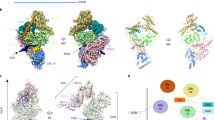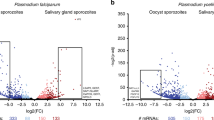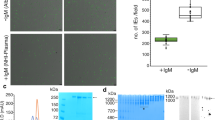Abstract
Pregnancy-associated malaria commonly involves the binding of Plasmodium falciparum-infected erythrocytes to placental chondroitin sulfate A (CSA) through the PfEMP1–VAR2CSA protein. VAR2CSA is translationally repressed by an upstream open reading frame. In this study, we report that the P. falciparum translation enhancing factor (PTEF) relieves upstream open reading frame repression and thereby facilitates VAR2CSA translation. VAR2CSA protein levels in var2csa-transcribing parasites are dependent on the expression level of PTEF, and the alleviation of upstream open reading frame repression requires the proteolytic processing of PTEF by PfCalpain. Cleavage generates a C-terminal domain that contains a sterile-alpha-motif-like domain. The C-terminal domain is permissive to cytoplasmic shuttling and interacts with ribosomes to facilitate translational derepression of the var2csa coding sequence. It also enhances translation in a heterologous translation system and thus represents the first non-canonical translation enhancing factor to be found in a protozoan. Our results implicate PTEF in regulating placental CSA binding of infected erythrocytes.
This is a preview of subscription content, access via your institution
Access options
Access Nature and 54 other Nature Portfolio journals
Get Nature+, our best-value online-access subscription
$29.99 / 30 days
cancel any time
Subscribe to this journal
Receive 12 digital issues and online access to articles
$119.00 per year
only $9.92 per issue
Buy this article
- Purchase on Springer Link
- Instant access to full article PDF
Prices may be subject to local taxes which are calculated during checkout






Similar content being viewed by others
References
Rao, Y. S. et al. Mutation bias is the driving force of codon usage in the Gallus gallus genome. DNA Res. 18, 499–512 (2011).
Rask, T. S., Hansen, D. A., Theander, T. G., Pedersen, A. G. & Lavstsen, T. Plasmodium falciparum erythrocyte membrane protein 1 diversity in seven genomes—divide and conquer. PLoS Comput. Biol. 6, e1000933 (2010).
Chen, Q. et al. Developmental selection of var gene expression in Plasmodium falciparum. Nature 394, 392–395 (1998).
Scherf, A. et al. Antigenic variation in malaria: in situ switching, relaxed and mutually exclusive transcription of var genes during intra-erythrocytic development in Plasmodium falciparum. EMBO J. 17, 5418–5426 (1998).
Salanti, A. et al. Selective upregulation of a single distinctly structured var gene in chondroitin sulphate A-adhering Plasmodium falciparum involved in pregnancy-associated malaria. Mol. Microbiol. 49, 179–191 (2003).
Salanti, A. et al. Evidence for the involvement of VAR2CSA in pregnancy-associated malaria. J. Exp. Med. 200, 1197–1203 (2004).
Dzikowski, R. et al. Mechanisms underlying mutually exclusive expression of virulence genes by malaria parasites. EMBO Rep. 8, 959–965 (2007).
Amulic, B., Salanti, A., Lavstsen, T., Nielsen, M. A. & Deitsch, K. W. An upstream open reading frame controls translation of var2csa, a gene implicated in placental malaria. PLoS Pathog. 5, e1000256 (2009).
Mok, B. W. et al. Default pathway of var2csa switching and translational repression in Plasmodium falciparum. PLoS One 3, e1982 (2008).
Bancells, C. & Deitsch, K. W. A molecular switch in the efficiency of translation reinitiation controls expression of var2csa, a gene implicated in pregnancy-associated malaria. Mol. Microbiol. 90, 472–488 (2013).
Kemp, D. J. et al. A chromosome-9 deletion in Plasmodium falciparum results in loss of cytoadherence. Mem. Inst. Oswaldo Cruz. 87, 85–89 (1992).
Francis, S. E. et al. Six genes are preferentially transcribed by the circulating and sequestered forms of Plasmodium falciparum parasites that infect pregnant women. Infect. Immun. 75, 4838–4850 (2007).
Fried, M. et al. The distinct proteome of placental malaria parasites. Mol. Biochem. Parasitol. 155, 57–65 (2007).
Ndam, N. T. et al. Plasmodium falciparum transcriptome analysis reveals pregnancy malaria associated gene expression. PLoS One 3, e1855 (2008).
Vignali, M. et al. NSR-seq transcriptional profiling enables identification of a gene signature of Plasmodium falciparum parasites infecting children. Eur. J. Clin. Invest. 121, 1119–1129 (2011).
Bertin, G. I. et al. Differential protein expression profiles between Plasmodium falciparum parasites isolated from subjects presenting with pregnancy-associated malaria and uncomplicated malaria in Benin. J. Infect. Dis. 208, 1987–1997 (2013).
Camarda, G. et al. Regulated oligomerisation and molecular interactions of the early gametocyte protein Pfg27 in Plasmodium falciparum sexual differentiation. Int. J. Parasitol. 40, 663–673 (2010).
Sharma, A., Sharma, I., Kogkasuriyachai, D. & Kumar, N. Structure of a gametocyte protein essential for sexual development in Plasmodium falciparum. Nature Struct. Biol. 10, 197–203 (2003).
Rutledge, G. G. et al. Plasmodium malariae and P. ovale genomes provide insights into malaria parasite evolution. Nature 542, 101–104 (2017).
Coppi, A., Pinzon-Ortiz, C., Hutter, C. & Sinnis, P. The Plasmodium circumsporozoite protein is proteolytically processed during cell invasion. J. Exp. Med. 201, 27–33 (2005).
Heiber, A. et al. Identification of new PNEPs indicates a substantial non-PEXEL exportome and underpins common features in Plasmodium falciparum protein export. PLoS Pathog. 9, e1003546 (2013).
Oehring, S. C. et al. Organellar proteomics reveals hundreds of novel nuclear proteins in the malaria parasite Plasmodium falciparum. Genome Biol. 13, R108 (2012).
Ghorbal, M. et al. Genome editing in the human malaria parasite Plasmodium falciparum using the CRISPR-Cas9 system. Nature Biotechnol. 32, 819–821 (2014).
Rug, M., Prescott, S. W., Fernandez, K. M., Cooke, B. M. & Cowman, A. F. The role of KAHRP domains in knob formation and cytoadherence of P falciparum-infected human erythrocytes. Blood 108, 370–378 (2006).
Waterkeyn, J. G. et al. Targeted mutagenesis of Plasmodium falciparum erythrocyte membrane protein 3 (PfEMP3) disrupts cytoadherence of malaria-infected red blood cells. EMBO J. 19, 2813–2823 (2000).
Soerli, J. et al. Human monoclonal IgG selection of Plasmodium falciparum for the expression of placental malaria-specific variant surface antigens. Parasite Immunol. 31, 341–346 (2009).
Mandava, C. S. et al. Bacterial ribosome requires multiple L12 dimers for efficient initiation and elongation of protein synthesis involving IF2 and EF-G. Nucleic Acids Res. 40, 2054–2064 (2012).
Ralph, S. A. et al. Transcriptome analysis of antigenic variation in Plasmodium falciparum—var silencing is not dependent on antisense RNA. Genome Biol. 6, R93 (2005).
Goel, S. et al. Targeted disruption of a ring-infected erythrocyte surface antigen (RESA)-like export protein gene in Plasmodium falciparum confers stable chondroitin 4-sulfate cytoadherence capacity. J. Biol. Chem. 289, 34408–34421 (2014).
Duffy, M. F. et al. Transcribed var genes associated with placental malaria in Malawian women. Infect. Immun. 74, 4875–4883 (2006).
Tuikue Ndam, N. G. et al. High level of var2csa transcription by Plasmodium falciparum isolated from the placenta. J. Infect. Dis. 192, 331–335 (2005).
Ukaegbu, U. E. et al. A unique virulence gene occupies a principal position in immune evasion by the malaria parasite Plasmodium falciparum. PLoS Genet. 11, e1005234 (2015).
Skabkin, M. A., Skabkina, O. V., Hellen, C. U. T. & Pestova, T. V. Reinitiation and other unconventional posttermination events during eukaryotic translation. Mol. Cell. 51, 249–264 (2013).
Kumar, M., Srinivas, V. & Patankar, S. Upstream AUGs and upstream ORFs can regulate the downstream ORF in Plasmodium falciparum. Malar. J. 14, 512 (2015).
Watanabe, J., Sasaki, M., Suzuki, Y. & Sugano, S. Analysis of transcriptomes of human malaria parasite Plasmodium falciparum using full-length enriched library: identification of novel genes and diverse transcription start sites of messenger RNAs. Gene 291, 105–113 (2002).
Caro, F., Ahyong, V., Betegon, M. & DeRisi, J. L. Genome-wide regulatory dynamics of translation in the Plasmodium falciparum asexual blood stages. Elife 3, e04106 (2014).
Schleich, S. et al. DENR-MCT-1 promotes translation re-initiation downstream of uORFs to control tissue growth. Nature 512, 208–212 (2014).
Xue, S. F. & Barna, M. Specialized ribosomes: a new frontier in gene regulation and organismal biology. Nature Rev. Mol. Cell. Biol. 13, 355–369 (2012).
Dinman, J. D. Pathways to specialized ribosomes: the Brussels lecture. J. Mol. Biol. 428, 2186–2194 (2016).
Velichutina, I. V., Rogers, M. J., McCutchan, T. F. & Liebman, S. W. Chimeric rRNAs containing the GTPase centers of the developmentally regulated ribosomal rRNAs of Plasmodium falciparum are functionally distinct. RNA 4, 594–602 (1998).
Li, J., McConkey, G. A., Rogers, M. J., Waters, A. P. & McCutchan, T. R. Plasmodium: the developmentally regulated ribosome. Exp. Parasitol. 78, 437–441 (1994).
Ganesan, K. et al. A genetically hard-wired metabolic transcriptome in Plasmodium falciparum fails to mount protective responses to lethal antifolates. PLoS Pathog. 4, e1000214 (2008).
Bozdech, Z. et al. The transcriptome of the intraerythrocytic developmental cycle of Plasmodium falciparum. PLoS Biol. 1, e5 (2003).
Florens, L. et al. A proteomic view of the Plasmodium falciparum life cycle. Nature 419, 520–526 (2002).
Lasonder, E. et al. Analysis of the Plasmodium falciparum proteome by high-accuracy mass spectrometry. Nature 419, 537–542 (2002).
Coulson, R. M. R., Hall, N. & Ouzounis, C. A. Comparative genomics of transcriptional control in the human malaria parasite Plasmodium falciparum. Genome Res. 14, 1548–1554 (2004).
Trager, W. & Jensen, J. B. Human malaria parasites in continuous culture. Science 193, 673–675 (1976).
Deitsch, K., Driskill, C. & Wellems, T. Transformation of malaria parasites by the spontaneous uptake and expression of DNA from human erythrocytes. Nucleic Acids Res. 29, 850–853 (2001).
Zheng, Z. et al. Titration-free 454 sequencing using Y adapters. Nature Protoc. 6, 1367–1376 (2011).
Zheng, Z. et al. Titration-free massively parallel pyrosequencing using trace amounts of starting material. Nucleic Acids Res. 38, e137 (2010).
Bolger, A. M., Lohse, M. & Usadel, B. Trimmomatic: a flexible trimmer for Illumina sequence data. Bioinformatics 30, 2114–2120 (2014).
Langmead, B., Trapnell, C., Pop, M. & Salzberg, S. L. Ultrafast and memory-efficient alignment of short DNA sequences to the human genome. Genome Biol. 10, R25 (2009).
Carver, T. et al. Artemis and ACT: viewing, annotating and comparing sequences stored in a relational database. Bioinformatics 24, 2672–2676 (2008).
Dobin, A. et al. STAR: ultrafast universal RNA-seq aligner. Bioinformatics 29, 15–21 (2013).
Traggiai, E. et al. An efficient method to make human monoclonal antibodies from memory B cells: potent neutralization of SARS coronavirus. Nature Med. 10, 871–875 (2004).
Tiller, T. et al. Efficient generation of monoclonal antibodies from single human B cells by single cell RT–PCR and expression vector cloning. J. Immunol. Methods 329, 112–124 (2008).
Koripella, R. K. et al. A conserved histidine in switch-II of EF-G moderates release of inorganic phosphate. Sci. Rep. 5, 12970 (2015).
Pang, Y. H. et al. The antiprion compound 6-aminophenanthridine inhibits the protein folding activity of the ribosome by direct competition. J. Biol. Chem. 288, 19081–19089 (2013).
Acknowledgements
The authors thank the Scilifelab in Stockholm for RNA-seq and mass spectrometry experiments, K.W. Deitsch for providing luciferase reporter plasmids and for guidance on our experimental design, BEI Resources and MR4 for supplying DSM1, and BILS for providing support for the transcriptomic analysis. This study was supported by the Swedish Research Council (VR/2012-2014/521-2011-3377 to M.W.), the Söderberg Foundation and Swedish Academy of Sciences (to M.W.), the Swedish Strategic Foundation (to M.W.), the EU EviMalar Network of Excellence (to M.W.), a Distinguished Professor Award from Karolinska Institutet (to M.W.) and the Swedish Research Council (VR 2013-8778, 2014-4423 and 2016-06264 to S.S.) and the Knut and Alice Wallenberg Foundation (KAW 2011.0081, RiboCORE to S.S.). The funders had no role in the study design, data collection and analysis, decision to publish, or preparation of the manuscript.
Author information
Authors and Affiliations
Contributions
S.C. and M.W. conceived the study. S.C., A.F., J.H.C. and M.P.Q. performed all experiments. C.S.M. and S.S. performed the RTTF assay. M.V. performed the MS experiment. J.J.L.R. and M.G. assisted in CRISPR design. S.B. and A.L. generated the recombinant PAM1.4. N.J. and O.F. performed computational analysis. S.C., A.F., C.S.M., S.S. and M.W. interpreted data and wrote the manuscript.
Corresponding author
Ethics declarations
Competing interests
M.W. is a co-founder and member of the board of directors of Modus Therapeutics AB, a company developing drugs for severe malaria. All other authors declare no financial conflicts of interest.
Supplementary information
Supplementary Information
Supplementary Figures 1-9, Supplementary Table 5, Supplementary References. (PDF 20363 kb)
Supplementary Table 1
One spreadsheet summarizing the list of genes deleted on the left arm of chromosome 2 and the right arm of chromosome 9 in 3D7S8.4.2 parasites. (XLSX 39 kb)
Supplementary Table 2
Eight spreadsheets providing a detailed description of all differentially expressed genes between NF54CSA and 3D7S8.4.2 at the four time points collected for the RNAseq experiment. (XLSX 168 kb)
Supplementary Table 3
Eight spreadsheets providing a list of all proteins detected in mass spectrometry from the blue native gel experiment related to Supplementary Fig. 5. (XLSX 89 kb)
Supplementary Table 4
Two spreadsheets describing the sequence similarity of all ribosomal proteins between Plasmodium falciparum and Homo sapiens. (XLSX 41 kb)
Rights and permissions
About this article
Cite this article
Chan, S., Frasch, A., Mandava, C. et al. Regulation of PfEMP1–VAR2CSA translation by a Plasmodium translation-enhancing factor. Nat Microbiol 2, 17068 (2017). https://doi.org/10.1038/nmicrobiol.2017.68
Received:
Accepted:
Published:
DOI: https://doi.org/10.1038/nmicrobiol.2017.68
This article is cited by
-
Antibiotic thermorubin tethers ribosomal subunits and impedes A-site interactions to perturb protein synthesis in bacteria
Nature Communications (2023)
-
Evolution of transcriptional control of antigenic variation and virulence in human and ape malaria parasites
BMC Ecology and Evolution (2021)



